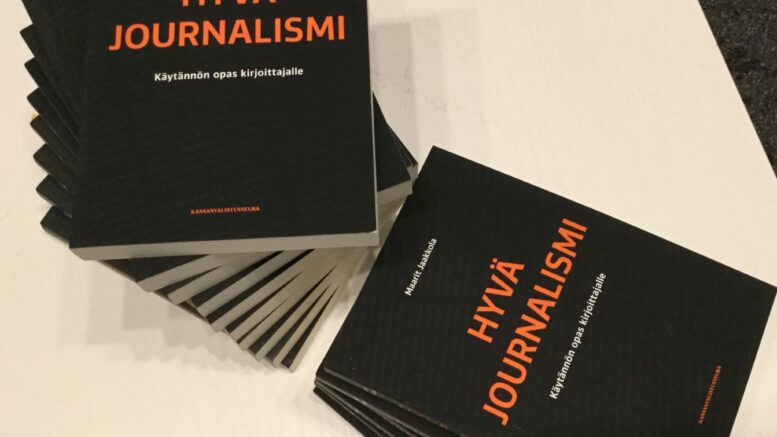My textbook in journalism, Hyvä journalismi [Good journalism], turns 10 years this year. It’s hard to believe that I wrote it already a decade ago – and, at the same time, it was only ten years ago when I put it together! While writing Hyvä journalismi (2013), I was working as a lecturer in journalism at the University of Tampere in Finland, the oldest journalism school in the Nordics.
The leading idea that I had in mind was to describe professional practice and thinking related to journalism, as an updated professional book was missing but clearly needed at that time. I conceptualized journalism as an ideology of timeliness, implying a standardized framework for thinking and action, adopted by newcomers who become socialized into the professional community. After its publication, the book has been used as obligatory readings in journalism study programmes at Finnish universities and universities of applied sciences.
The book is based on my lectures in journalism and journalistic practice at the university, or, actually, at different educational instances, as I also collected pedagogical experiences from the upper secondary school and vocational education. I started gathering exercises and questions I used frequently in the classroom with different groups – which were quite many, as there were at least 80–90 university students passing the training newsroom’s practical programme on a yearly basis.
At the time of writing journalism and journalism education were approaching the advent of one more crisis, which broke out later in the 2010’s: it was rumoured that journalism would soon be dead because of digitalization, and because journalists would be no longer needed when content creators and communicators would take over the public communication. Therefore, I tried to focus on dimensions that are as close to the core of journalism as possible and thus changing slower: instead of technologies, I chose to focus on values of journalism.
A lot has happened since the time of writing, not the least when it comes to the digital technologies’ effects on journalistic thinking and behaviour. A lot more will happen within the next years when artificial intelligence (AI) will alter many established routines and practices, and thus even professional ideas and identities. To catch up with this development, I have been considering to possibly revise the book at some point. Time will tell.
In the meanwhile, I wrote a text for the Swedish Media Council about the challenge of writing textbooks based on academic research and evidence in times of rapid technological change. The heading, in Swedish, suggests that research is challenged by the rapid technological development, but it is an edited title and the original version said that writing textbooks is challenging because of the rapid technological development. And, indeed, it is; this is something I and my journalism studies colleague Jenny Wiik are experiencing when writing on a textbook on AI in journalism.
But that’s another story, let us come back to that later when our work has proceeded.
What others say about the book:
- Blog Lukujonossa (2019): “Three good guidebooks for aspiring journalists” (3 hyvää opasta toimittajanaluille, in Finnish): “A plus for the fact that online journalism and social media are described at such a general level that the text is still valid, even if the book is five years old.”
- Folk high school Alkio-opisto’s blog (2020): “My day – distance studies” (Päivä kanssani – etäopiskelu, in Finnish): “About that book I need to say that if you are interested in journalism, I really recommend this piece! — This literally practical guidebook has been very helpful! Awesome to read a textbook that does not feel obligatory reading at all, haha :D”

Be the first to comment on "My journalism textbook turns 10 years"